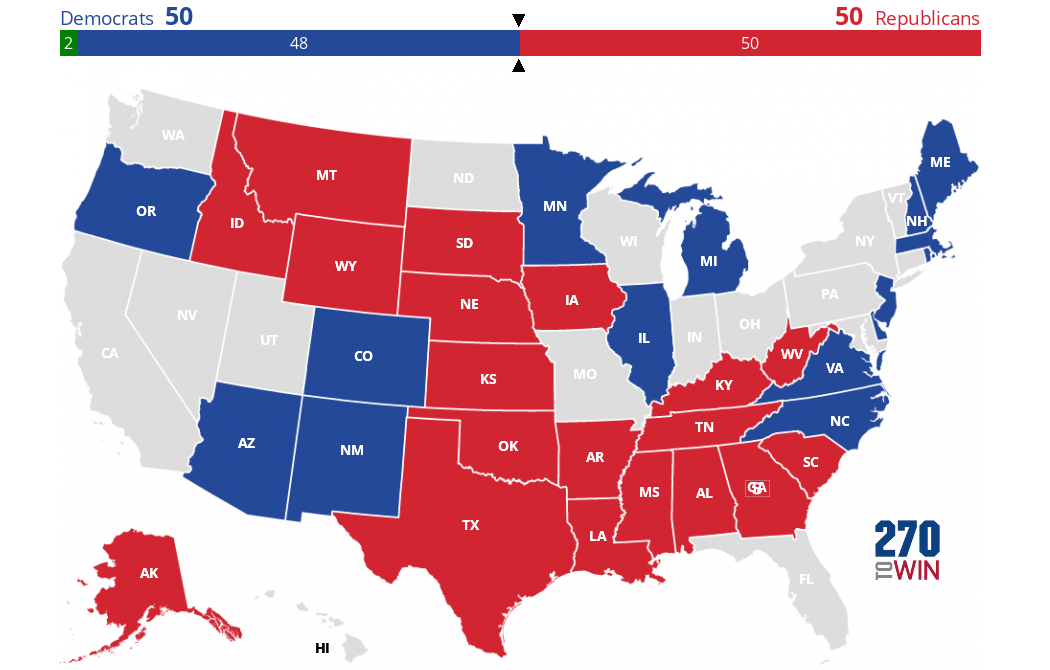It’s important to remember that, whomever is elected President on November 3rd, they will still have to contend with the Senate and House of Representatives, and the party and leaders who control them. A Senate and House under the control of the opposing party can make a President’s job more difficult – although there is no guarantee that it would be any easier if they were the same party – and Presidents have to be able to reach across the aisle and work with both parties to pass legislation.
Elections to the House of Representatives and to one third of the seats in the Senate are also taking place on November 3rd alongside the Presidential Election. Today I am going to give my final thoughts as to the way I think these elections might go.
Let’s look at the Senate first. The Senate has been under Republican control since 2015, after Mitch McConnell’s party gained control from the Democrats after a series of decisive victories in the 2014 midterm elections. This time around, however, the Senate Republicans are on the defensive, and in a precarious position.
The Republicans currently hold 53 out of 100 seats in the Senate, so a loss of three seats would lead to a tied Senate, while a loss of four seats would lead to loss of control of the Senate. Unfortunately for the Republicans, the Democrats are leading in a number of key Senate races. In Arizona’s special election, former astronaut Mark Kelly has been enjoying consistent poll leads over Republican Martha McSally for some time, while in Colorado, a state which has been trending more Democratic, Cory Gardener’s loss to former Governor John Hickenlooper seems like another likely Democrat pickup.
However, the Democrats also have a good chance to expand their Senate territory elsewhere in the country: in North Carolina, Cal Cunningham is hoping to unseat Thom Tillis, whilst attempting to keep his campaign afloat following recent revelations regarding his personal life; Cunningham currently has an average 1.6-point poll lead according to RealClearPolitics – way down from leads of between 6 and 10 points he had previously been enjoying. Meanwhile, in Maine, Sara Gideon could be set to deny Susan Collins a fifth Senate term; Collins has not led in a major poll so far this year.
So there are four potential seats for the Democrats to pick up in order to flip the Senate. However, a good night for them could leave the door open for further pickups: in Iowa, Theresa Greenfield has been leading incumbent Republican Joni Ernst in a number of major polls. However, Greenfield has no previous elected experience, and if Donald Trump is able to hold onto the state at the Presidential level, this may count against her. Elsewhere, popular Montana Governor Steve Bullock is another hopeful for a Democrat gain, and the runoff system in Georgia’s Senate elections could give the Democrats a chance to sneak in.
However, I am going to keep my estimates for the Senate elections more conservative. If the Democrats pick up four seats – Arizona, Colorado, Maine and North Carolina – while losing the seat in Alabama lent to Doug Jones in 2017 to keep Roy Moore out, that would give the Democrats 48 seats in the Senate to 50 for the Republicans. Along with the two independent Senators who caucus with the Democrats, that would leave the Senate with a 50-50 split, meaning that the Vice President – be that Kamala Harris or Mike Pence – would be more likely to have to step in to break tied votes.

Now for the House of Representatives. The House has been under Democratic control since January 2019, when the party regained control of the House in the November 2018 elections after 8 years as the minority party. This time around, I don’t actually expect much change either way, the Democrats and Republicans may trade a couple of seats here and there: the GOP might pick up a couple of rural districts in Republican-trending areas, such as Minnesota’s 7th District, where Collin Peterson is running for a 15th term, or perhaps one of the Democrats’ districts in Iowa. Meanwhile, the Democrats could set their sights on a couple of suburban seats where the incumbent Republicans are not running for re-election, such as Texas’s 22nd and 24th districts.
However, I am not expecting a lot of movement in the makeup of the House of Representatives after Tuesday’s election, save to say that the Democrats will retain control. As a ball park figure, I would suggest that the Democrats will win around 238 seats in the House, with the Republicans winning 197. Nancy Pelosi would then serve another term as House Speaker, barring any challenges.

We have just days now to go until the elections on November 3rd, and there is still everything to play for. Aside from the Presidential Election which is far from certain, the makeup and control of both the Senate and the House of Representatives hang on some very close races. These maps serve as a reminder of how much is at stake in Tuesday’s elections.